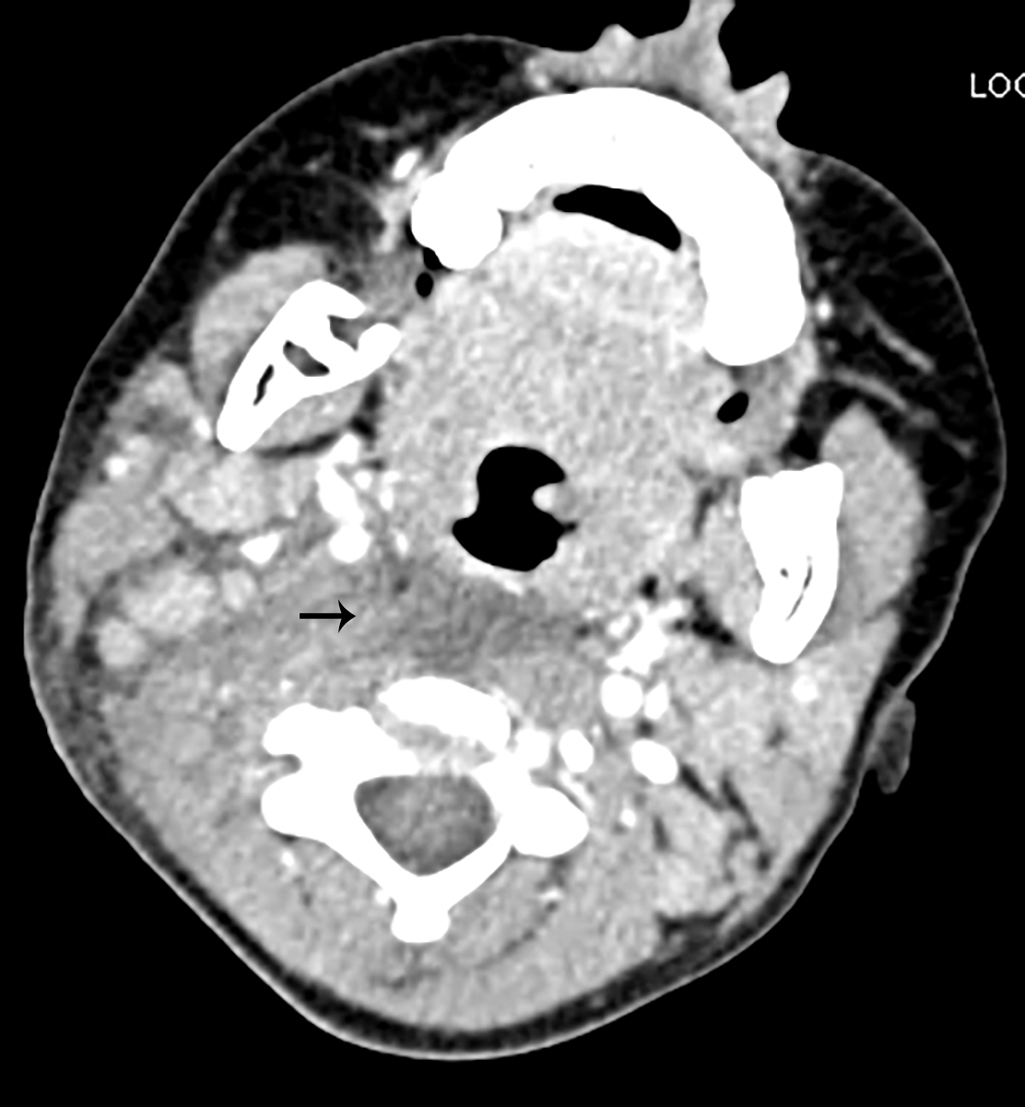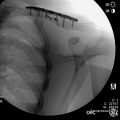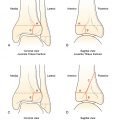Case presentation
A 4-year-old child is referred from her primary care provider’s office over concerns for meningitis. The patient has had fever and decreased oral intake and has not wanted to move her neck or head for the past 3 days. She has had rhinorrhea and mild cough for the past 3 days. She was seen by her primary care physician initially, who diagnosed an upper respiratory infection. The patient returned to her primary care provider when it was noted she did not want to move her neck or head.
Her physical examination reveals an anxious child in no immediate distress. She has a temperature of 103 degrees Fahrenheit, a heart rate of 120 beats per minute, respiratory rate of 30 breaths per minute, and a blood pressure of 85/40 mm Hg. Her examination reveals a mildly erythematous oropharynx without palatal petechiae or asymmetry. She is tilting her head toward the left and has very limited range of motion of the neck. In fact, she is refusing to move her neck or head. There is scattered anterior cervical lymphadenopathy that is nontender and without fluctuance. Her tympanic membranes are clear and there is no mastoid tenderness, erythema, or fluctuance.
Imaging considerations
The retropharyngeal space is not usually well visualized on imaging without the presence of a pathologic process. , Imaging often plays a role in both the diagnosis and the management of patients with suspected deep soft tissue neck infections.
Plain radiography
This imaging modality can be useful in assessing for the presence of an infection in the deep spaces of the neck. Plain radiography is available and rapid and has minimal exposure to ionizing radiation with adherence to pediatric imaging protocols. The presence of an increase in the width of the soft tissue space anterior to the cervical spine with narrowing of the oropharyngeal airway should prompt the clinician to consider such infections. In children younger than 5 years of age, the retropharyngeal space normally measures one-half of the full width of the adjacent vertebral body; in older children, a second cervical (C2) prevertebral width of greater than 7 mm and sixth cervical (C6) width of up to 14 mm are acceptable. , Some authors propose that prevertebral space measurements greater than these measurements, with clinical findings to support a deep neck space infection, are sufficient to make the diagnosis of a retropharyngeal abscess (RPA). , , However, obtaining lateral neck radiographs can be challenging in pediatric patients, who may not cooperate behaviorally to produce a meaningful study. Flexion of the neck, crying, swallowing, and rotational artifacts can lead to difficulty interpreting these radiographs. , , Additional indications of a deep neck infection may include gas within the soft tissues of the neck, prevertebral or retropharyngeal soft tissue thickening, cervical spine straightening (loss of lordosis) on the lateral view, and torticollis on anterior-posterior projections. ,
Computed tomography (CT)
Intravenous contrast-enhanced CT is the study of choice for imaging patients with suspected neck deep tissue infection. , , , Patients with an RPA will demonstrate characteristic fluid in the retropharyngeal space and peripheral rim-like enhancement, defining the abscess, which appears as a homogenous area of hypodensity. , CT can have difficulty in distinguishing between RPA and cellulitis but remains the imaging modality of choice for these patients. If a peritonsillar abscess is suspected, CT is an excellent modality to visualize this disease process. A peritonsillar abscess will be seen as diffuse enlargement and enhancement of the affected tonsil with an associated fluid collection surrounded by rim-like enhancement, although sometimes, the differentiation between a peritonsillar abscess and a necrotic retropharyngeal lymph node may be difficult.
CT can be utilized to make management decisions in patients with deep soft tissue neck infections (i.e., antibiotics versus surgical intervention). This modality is also useful when evaluating the relationship between the infection and surrounding anatomic structures, including proximity to the great blood vessels and other vascular structures. , , , CT also has the advantage of narrowing the differential diagnosis by detecting trauma, foreign bodies, and congenital anatomic abnormalities (such as branchial cleft cysts and thyroglossal duct cysts, both of which can become infected). This modality does expose the patient to ionizing radiation, which can be minimized by adherence to As Low As Reasonably Achievable (ALARA) principles. The test is rapid and sedation is not generally needed.
Ultrasound
Ultrasound has the advantages of rapidity and availability while not requiring sedation or exposing the child to ionizing radiation. This imaging modality has been utilized for superficial neck infections in pediatric patients, decreasing the need for CT use, but is not helpful in evaluating suspected deep space infections. , , However, ultrasound can miss a significant subset of patients who have lateral neck infections associated with deep coexisting retropharyngeal infection ultimately detected by CT (10%), and these patients require repeat imaging, the majority of the time (80%) employing CT.
Magnetic resonance imaging (MRI)
MRI is not used as a first-line imaging modality in patients with suspected deep soft tissue infections of the neck. However, MRI may be indicated in patients with suspected complications of such neck infections, particularly if there is concern for vascular complications such as jugular venous thrombosis.
Imaging findings
The history and physical examination findings were suspicious for a deep soft tissue neck infection, rather than meningitis. Therefore, CT imaging with intravenous contrast was obtained. Selected images from that study are included here. These images demonstrate a large right retropharyngeal hypodensity extending from the nasopharynx to the level of the hyoid bone, compatible with retropharyngeal phlegmon, extending along the right aspect of the skull base, C1, and C2 vertebral bodies ( Fig. 82.1 ).

Case conclusion
The patient was given intravenous clindamycin and admitted for intravenous fluids. Pediatric Otolaryngology was consulted, and recommended continuation of the clindamycin. Over 48 hours, the patient improved and was able to take oral fluids. She was discharged with oral antibiotics to complete a 10-day course and recovered uneventfully.
RPA is uncommon, mostly seen in children between the ages of 2 and 4 years, but can occur in all age groups from neonates to adults. , , , , The retropharyngeal space extends from the base of the skull to the posterior mediastinum and laterally into the pharyngeal space. In children, lymphatic chains that drain the upper airway respiratory structures are located within this space and are the typical source of infection, which can extend into the potential spaces within the layers of the deep cervical facia and down into the mediastinum. , , , , Infection is thought to begin as an upper respiratory infection (usually viral) leading to a suppurative process of these regional lymph nodes, culminating in abscess formation. Abscess formation can also be associated with trauma to the area or a foreign body.
The clinical presentation of an RPA can vary and the differential diagnosis is broad, which can include infectious processes (meningitis, for example), trauma, tumors/masses, and congenital anomalies. A thorough history and physical examination will help narrow the differential diagnosis. There are no specific diagnostic symptoms. Fever, neck pain, and dysphagia are common symptoms; in infants, decreased oral intake, drooling, fussiness, and limited neck motion may also be seen. Some patients may present with signs of upper airway obstruction, such as stridor or respiratory distress. In these patients, great care must be taken during the physical examination not to exacerbate potential airway compromise, which can lead to patient decompensation; in some cases, examination in the operating suite under sedation with a controlled airway may be indicated in toxic-appearing patients who may have tenuous airways or signs of impending airway compromise. , , , ,
Management of an RPA is dependent on the size of the abscess as well as associated complications. Management involves both medical and surgical options.
Medical management
Small abscesses (less than 2 cm) and associated retropharyngeal cellulitis without associated complications are usually treated with intravenous antibiotics. , , , In one series, failure of medical management was based on the size of the abscess alone, with medical management likely to fail in patients with abscess size greater than 2 cm; these patients subsequently required surgical intervention. Antibiotic choice should cover Gram-positive and anaerobic organisms, although infections are typically polymicrobial, with Streptococcus species, Fusobacterium , and Peptostreptococcus species as common culprits. Antibiotic regimen should be guided by local antibiograms and preferences.
Surgical management
Large abscesses (≥2 cm), the presence of airway compromise, and failing intravenous antibiotic therapy are indications for surgical management in patients with RPA. , , , Patients in whom it is difficult to reach the abscess may benefit from CT-guided abscess drainage. It may be appropriate to utilize 24 to 48 hours of intravenous broad-spectrum antibiotic therapy prior to surgical intervention. , , , ,
Complications from an RPA, aside from airway obstruction, include aspiration pneumonia, carotid artery pseudoaneurysm, septic thrombophlebitis of the internal jugular vein (Lemierre syndrome), atlantoaxial dislocation, and mediastinitis. , , , ,
Corollary case: Peritonsillar abscess
These are common deep space neck infections in the pediatric population. These infections have a reported incidence of 9 out of 100,000 patients younger than 20 years of age and peak in the adolescent time period. , As with RPA, these infections are often polymicrobial. Clinical presentation is also similar to RPA and common symptoms are sore throat with fever. Dysphagia, voice changes, and trismus may be present. A classic physical examination finding is unilateral uvular deviation and unilateral posterior pharyngeal fullness, , corresponding to abscess location. Interestingly, younger children are more likely to have a neck mass.
Imaging may play a role in the diagnosis of a peritonsillar abscess. However, patients with a clinical history and examination consistent with a peritonsillar abscess do not generally require imaging. If the diagnosis is in question, imaging is appropriate. Oral ultrasonography may be utilized and has been demonstrated effective for evaluating and detecting peritonsillar abscesses. , However, young patients may not tolerate this procedure well. CT with intravenous contrast can be utilized in cases where the diagnosis is in question, since this modality is excellent for detecting a deep neck abscess or identifying an alternative diagnosis. , MRI is superior to CT for delineating soft tissues and identifying complications from a peritonsillar abscess. , Management consists of drainage (either aspiration or incision), which in adolescents and cooperative older children may be done at the bedside, but younger children may require performance of this procedure in the operating suite. Antibiotic choice is the same as with RPA. As with a small (less than 2 cm) RPA, intravenous antibiotics may be initially used without surgical treatment for 24 to 48 hours with close monitoring; if there is a lack of response or worsening clinical condition, then surgical management is indicated. , Older patients in whom bedside drainage is tolerated, have adequate pain control, and adequate oral intake can often be discharged with appropriate antibiotics. , Complications associated with a peritonsillar abscess are similar to those of an RPA.
A 15-year-old patient presented with 4 days of sore throat and voice change. The physical examination was remarkable for pharyngeal erythema but minimal asymmetry of the oropharynx. An intravenous contrast-enhanced CT examination was obtained and a selected image is presented here ( Fig. 82.2 ). There is a 1.9 × 3.1 × 3.4-cm peripherally enhancing fluid collection with mild mass effect in the right retropharyngeal space with deviation of the oropharyngeal airway to the left. This is consistent with an abscess secondary to a suppurative lymph node. Pediatric Otolaryngology was consulted and the decision was made to perform drainage in the operating suite. This was done without incident.









